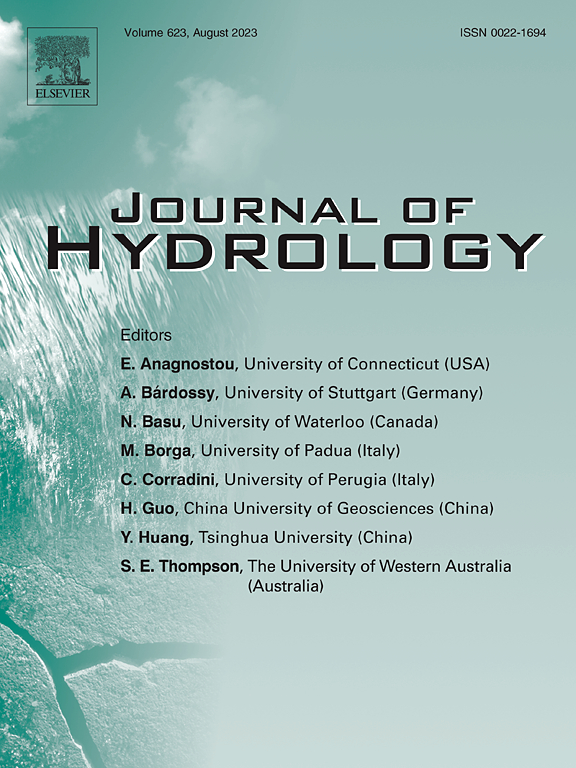GRACE/ML-based analysis of the spatiotemporal variations of groundwater storage in Africa
IF 5.9
1区 地球科学
Q1 ENGINEERING, CIVIL
引用次数: 0
Abstract
Groundwater is a crucial factor influencing the ecological security and social-economic development in Africa. To support comprehensive and sustainable management of groundwater resources in Africa, GRACE and GLDAS data were utilized to extract information about groundwater storage anomaly (GWSA) in Africa and its different basins. Theil-Sen Median method, Mann-Kendall (MK) trend test and the seasonal and trend decomposition LOESS method (STL) were applied to reveal the long-term and seasonal spatiotemporal trends in GWSA. Additionally, an interpretable machine learning algorithm namely Extreme Gradient Boosting and SHAP model (XGBoost-SHAP) was employed to analyze the driving processes of the factors impacting GWSA in different basins. The study results indicate that GWSA in Africa exhibited an overall upward trend, with significant seasonal characteristics. In sub-Saharan African basins, GWSA showed a significant increase trend, with annual growth rates ranging from 2.75 cm/a to 8.02 cm/a. In contrast, a declining GWSA trend was observed in the Sahara region, with an annual decrease rate of 2.62 cm/a. Quantitative analysis identified population density and normalized difference vegetation index (NDVI) as the key factors influencing GWSA. These findings allowed us to categorize the underlying mechanisms driving GWSA across African basins into three types: (1) anthropogenic activity-dominated regions; (2) natural factor-dominated regions; (3) regions controlled by the interaction of natural factors and human activities. Understanding and monitoring the spatiotemporal heterogeneity of GWSA and the differences in driving factors across different basins is critical for a substantial improvement in the management of groundwater resources in the different basins across Africa.
基于 GRACE/ML 的非洲地下水储量时空变化分析
地下水是影响非洲生态安全和社会经济发展的关键因素。为支持非洲地下水资源的全面和可持续管理,利用全球大气环流卫星数据和全球土地退化评估系统数据提取了非洲及其不同盆地的地下水储存异常(GWSA)信息。应用 Theil-Sen 中值法、Mann-Kendall(MK)趋势检验法以及季节和趋势分解 LOESS 法(STL)来揭示 GWSA 的长期和季节时空趋势。此外,还采用了一种可解释的机器学习算法,即极端梯度提升和 SHAP 模型(XGBoost-SHAP)来分析影响不同流域 GWSA 的因素的驱动过程。研究结果表明,非洲的 GWSA 总体呈上升趋势,并具有显著的季节性特征。在撒哈拉以南非洲盆地,GWSA 呈显著上升趋势,年增长率从 2.75 厘米/年到 8.02 厘米/年不等。与此相反,撒哈拉地区的 GWSA 呈下降趋势,年下降率为 2.62 cm/a。定量分析发现,种群密度和归一化差异植被指数(NDVI)是影响 GWSA 的关键因素。这些发现使我们能够将非洲各盆地的全球降水量增加的内在机制分为三类:(1)人为活动主导的区域;(2)自然因素主导的区域;(3)自然因素和人类活动相互作用控制的区域。了解和监测不同流域全球降水和地下水系统的时空异质性以及驱动因素的差异,对于大幅改善非洲不同流域的地下水资源管理至关重要。
本文章由计算机程序翻译,如有差异,请以英文原文为准。
求助全文
约1分钟内获得全文
求助全文
来源期刊

Journal of Hydrology
地学-地球科学综合
CiteScore
11.00
自引率
12.50%
发文量
1309
审稿时长
7.5 months
期刊介绍:
The Journal of Hydrology publishes original research papers and comprehensive reviews in all the subfields of the hydrological sciences including water based management and policy issues that impact on economics and society. These comprise, but are not limited to the physical, chemical, biogeochemical, stochastic and systems aspects of surface and groundwater hydrology, hydrometeorology and hydrogeology. Relevant topics incorporating the insights and methodologies of disciplines such as climatology, water resource systems, hydraulics, agrohydrology, geomorphology, soil science, instrumentation and remote sensing, civil and environmental engineering are included. Social science perspectives on hydrological problems such as resource and ecological economics, environmental sociology, psychology and behavioural science, management and policy analysis are also invited. Multi-and interdisciplinary analyses of hydrological problems are within scope. The science published in the Journal of Hydrology is relevant to catchment scales rather than exclusively to a local scale or site.
 求助内容:
求助内容: 应助结果提醒方式:
应助结果提醒方式:


